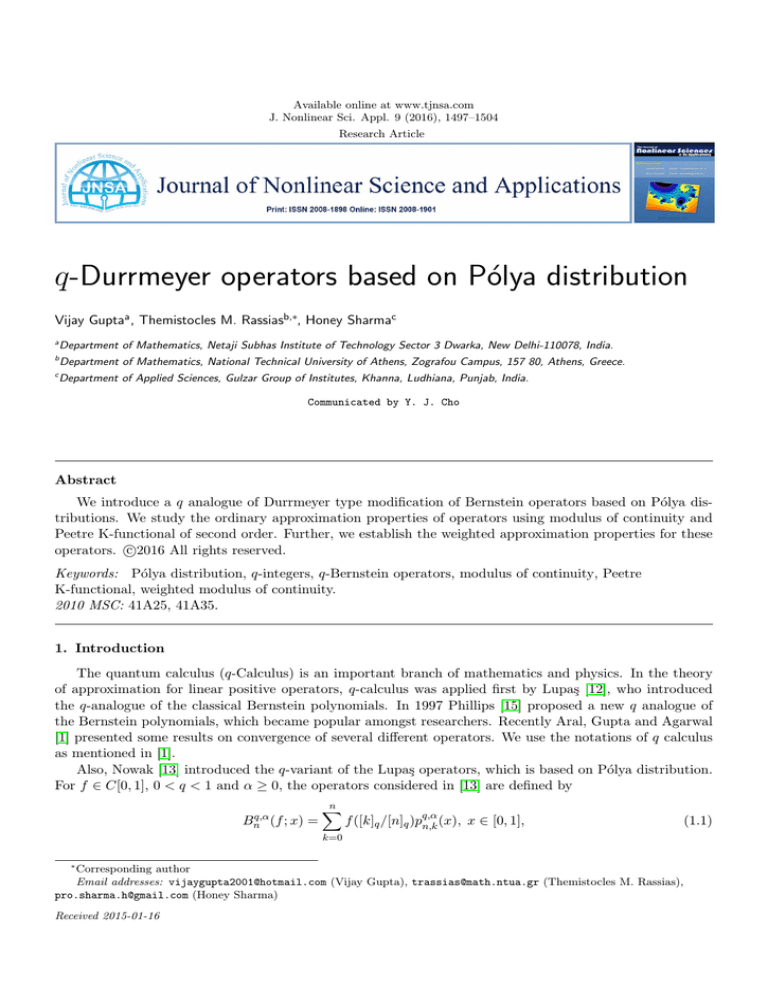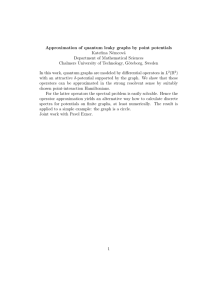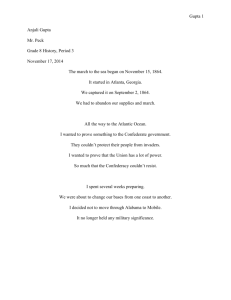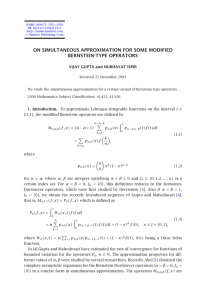
Available online at www.tjnsa.com
J. Nonlinear Sci. Appl. 9 (2016), 1497–1504
Research Article
q-Durrmeyer operators based on Pólya distribution
Vijay Guptaa , Themistocles M. Rassiasb,∗, Honey Sharmac
a
Department of Mathematics, Netaji Subhas Institute of Technology Sector 3 Dwarka, New Delhi-110078, India.
b
Department of Mathematics, National Technical University of Athens, Zografou Campus, 157 80, Athens, Greece.
c
Department of Applied Sciences, Gulzar Group of Institutes, Khanna, Ludhiana, Punjab, India.
Communicated by Y. J. Cho
Abstract
We introduce a q analogue of Durrmeyer type modification of Bernstein operators based on Pólya distributions. We study the ordinary approximation properties of operators using modulus of continuity and
Peetre K-functional of second order. Further, we establish the weighted approximation properties for these
c
operators. 2016
All rights reserved.
Keywords: Pólya distribution, q-integers, q-Bernstein operators, modulus of continuity, Peetre
K-functional, weighted modulus of continuity.
2010 MSC: 41A25, 41A35.
1. Introduction
The quantum calculus (q-Calculus) is an important branch of mathematics and physics. In the theory
of approximation for linear positive operators, q-calculus was applied first by Lupaş [12], who introduced
the q-analogue of the classical Bernstein polynomials. In 1997 Phillips [15] proposed a new q analogue of
the Bernstein polynomials, which became popular amongst researchers. Recently Aral, Gupta and Agarwal
[1] presented some results on convergence of several different operators. We use the notations of q calculus
as mentioned in [1].
Also, Nowak [13] introduced the q-variant of the Lupaş operators, which is based on Pólya distribution.
For f ∈ C[0, 1], 0 < q < 1 and α ≥ 0, the operators considered in [13] are defined by
Bnq,α (f ; x) =
n
X
f ([k]q /[n]q )pq,α
n,k (x), x ∈ [0, 1],
k=0
∗
Corresponding author
Email addresses: vijaygupta2001@hotmail.com (Vijay Gupta), trassias@math.ntua.gr (Themistocles M. Rassias),
pro.sharma.h@gmail.com (Honey Sharma)
Received 2015-01-16
(1.1)
V. Gupta, T. M. Rassias, H. Sharma, J. Nonlinear Sci. Appl. 9 (2016), 1497–1504
where
pq,α
n,k (x)
=
n
K
Qk−1
i=0 (x
q
1498
Q
(1 − q j x + [j]q α)
+ [i]q α) n−k−1
j=0
.
Qn−1
l=0 (1 + [l]q α)
Note that empty product in the above basis function pq,α
n,k (x) is denoted by 1. Nowak in [13] and Nowak and
Gupta in [14] estimated the moments and established some direct estimates for the operators (1.1).
In the year 2008 Gupta [6] introduced q-Durrmeyer operators. Some other results and forms of qDurrmeyer type operators were discussed in [2, 5, 7, 10, 11] and [8] etc. We now introduce the q-analogue
of Lupaş Durrmeyer operators for f ∈ C[0, 1] and 0 < q < 1 by
q,1/[n]q
Dn
(f ; x)
= [n + 1]q
n
X
q,1/[n]
q −k pn,k q (x)
Z
k=0
where
q,1/[n]
pn,k q (x)
=
n
k
Qk−1 (x +
i=0
q
and
pqn,k (qt)
=
n
k
q k tk
q
1
0
pqn,k (qt)f (t)dq t,
[i]q Qn−k−1
(1 −
i=0
[n]q )
Qn−1
[i]q
i=0 (1 + [n]q )
n−k−1
Y
x+
x ∈ [0, 1],
(1.2)
[i]q
[n]q )
(1 − q j+1 t).
j=0
As a special case when q → 1, we get the operators due to Gupta and Rassias [9].
2. Lemmas
Lemma 2.1. For ei = ti , i = 0, 1, 2, 3, 4, the moments of q-Lupaş operators based on Pólya distribution are
Bnq,α (e0 ; x) = 1,
Bnq,α (e1 ; x) = x,
Bnq,α (e2 ; x)
1
=
1+α
x(1 − x)
x(x + α) +
,
[n]q
2
X
1
W k (q, α; x)
,
k
[n]
(1
+
[i]
α)
q
q
i=0
k=0
Bnq,α (e3 ; x) = Q2
Bnq,α (e4 ; x)
3
X
1
Wk (q, α; x)
= Q3
,
[n]kq
i=0 (1 + [i]q α) k=0
where
W 0 (q, α; x) = x(x + α)(x + [2]q α),
W 1 (q, α; x) = x(1 − x)(x + α)(2 + q),
W 2 (q, α; x) = x(1 − x)(1 − [2]q x),
W0 (q, α; x) = x(x + α)(x + [2]q α)(x + [3]q α),
W1 (q, α; x) = x(1 − x)(x + α)(x + [2]q α)(q 2 + 2q + 3),
W2 (q, α; x) = x(1 − x)(x + α) (q 2 + 3q + 3)x(x + α) − [2]2q (x + α − [2]q x(1 + [3]q α)) ,
W3 (q, α; x) = x(1 − x)(x + α)([2]q x([3]q x − q − 2) + 1 − qα).
V. Gupta, T. M. Rassias, H. Sharma, J. Nonlinear Sci. Appl. 9 (2016), 1497–1504
1499
Lemma 2.2. For all x ∈ [0, 1], n ∈ N and q ∈ (0, 1), we have
q,1/[n]q
Dn
(e0 ; x) = 1,
q[n]q x + 1
q,1/[n]q
Dn
(e1 ; x) =
,
[n + 2]q
[n]3q q 3
x(1 − x)
q,1/[n]q
Dn
(e2 ; x) =
x(x + 1/[n]q ) +
(1 + [n]q )[n + 2]q [n + 3]q
[n]q
q(2q + 1)[n]q x
q+1
+
+
,
[n + 2]q [n + 3]q
[n + 2]q [n + 3]q
q,1/[n]q
(e3 ; x) =
q,1/[n]q
(e4 ; x) =
Dn
Dn
2
X
a1 (q)[n]3q
W k (q, 1/[n]q ; x)
1
Q2
[n + 2]q [n + 3]q [n + 4]q i=0 (1 + [i]q /[n]q )
[n]kq
k=0
a2 (q)[n]3q
x(1 − x)
+
x(x + 1/[n]q ) +
(1 + [n]q )[n + 2]q [n + 3]q [n + 4]q
[n]q
a3 (q)[n]q x
a4 (q)
+
+
,
[n + 2]q [n + 3]q [n + 4]q
[n + 2]q [n + 3]q [n + 4]q
3
X
b1 (q)[n]4q
Wk (q, 1/[n]q ; x)
1
Q
[n + 2]q [n + 3]q [n + 4]q [n + 5]q 3i=0 (1 + [i]q /[n]q )
[n]kq
k=0
2
b2 (q)[n]3q
X W k (q, 1/[n]q ; x)
1
[n + 2]q [n + 3]q [n + 4]q [n + 5]q i=0 (1 + [i]q /[n]q )
[n]kq
k=0
b3 (q)[n]3q
x(1 − x)
+
x(x + 1/[n]q ) +
([n]q + 1)[n + 2]q [n + 3]q [n + 4]q [n + 5]q
[n]q
b4 (q)[n]q x
a4 (q)
+
.
+
[n + 2]q [n + 3]q [n + 4]q [n + 5]q
[n + 2]q [n + 3]q [n + 4]q [n + 5]q
+
Q2
We have
Z
0
1
pqn,k (qt)ts dq t = q k
[s + k]q ![n]q !
,
[s + n + 1]q ![k]q !
using the methods described in [6] and Lemma 2.1. The proof of the lemma follows immediately and thus
we omit the details.
q,1/[n]q
Corollary 2.3. For central moments, denoted by φqn,m (x) = Dn
φqn,1 (x) =
φqn,2 (x)
((t − x)m , x), m = 1, 2, we have
(q[n]q − [n + 2]q )x + 1
,
[n + 2]q
([n]q − 1)[n]2q q 3
2q[n]q
1+
−
(1 + [n]q )[n + 2]q [n + 3]q
[n + 2]q
=
x2
2[n]2q q 3
q(2q + 1)[n]q
2
+
−
(1 + [n]q )[n + 2]q [n + 3]q
[n + 2]q [n + 3]q
[n + 2]q
+
+
!
!
x
q+1
.
[n + 2]q [n + 3]q
Lemma 2.4. For q ∈ (0, 1) and n > 3, we have
φqn,2 (x) =
where δn2 (x) = ϕ2 (x) +
1
[n+2]q
3
δ 2 (x),
[n + 2]q n
and ϕ2 (x) = x(1 − x).
(2.1)
V. Gupta, T. M. Rassias, H. Sharma, J. Nonlinear Sci. Appl. 9 (2016), 1497–1504
1500
Proof. By using Corollary 2.3 and simple computation, we obtain
φqn,2 (x)
=x(1 − x)
+ x2
+
[n]2q q(2q + 1) − [n]q (2q 3 + q + 2) − 2(q 2 + q + 1)
(1 + [n]q )[n + 2]q [n + 3]q
!
[n]3q (q 2 − 2q + 1) + [n]2q q(q 4 − q 2 + q − 1) + [n]q (2q 4 − q 3 + q 2 − q − 1) + q 3 − 1
(1 + [n]q )[n + 2]q [n + 3]q
!
q+1
.
[n + 2]q [n + 3]q
Clearly for n > 3, we have
and
[n]2q q(2q + 1) − [n]q (2q 3 + q + 2) − 2(q 2 + q + 1) > 0
(2.2)
[n]2q q(2q + 1) − [n]q (2q 3 + q + 2) − 2(q 2 + q + 1)
3
≤
.
(1 + [n]q )[n + 2]q [n + 3]q
[n + 3]q
(2.3)
Also, as q ∈ (0, 1), we obtain
[n]3q (q 2 − 2q + 1) + [n]2q q(q 4 − q 2 + q − 1) + [n]q (2q 4 − q 3 + q 2 − q − 1) + q 3 − 1
= [n]3q (q − 1)2 + [n]2q q(q − 1)(q 3 + q 2 + 1) + [n]q (q − 1)(q 2 + 1)(2q + 1) + (q − 1)(q 2 + q + 1)
= (q − 1) [n]3q (q − 1) + [n]2q q(q 3 + q 2 + 1) + [n]q (q 2 + 1)(2q + 1) + (q 2 + q + 1)
≤ 0.
Finally, by using the above inequality, (2.2) and (2.3), we get
3
q+1
+
[n + 3]q
[n + 2]q [n + 3]q
3
1
=
x(1 − x) +
.
[n + 2]q
[n + 2]q
φqn,2 (x) ≤ x(1 − x)
3. Local Approximation
Let us consider:
W 2 = {g ∈ C[0, 1] : g 0 , g 00 ∈ C[0, 1]}.
The Peetre’s K-functional for δ > 0 is defined by
K2 (f, δ) =
inf
||f − g|| + δ||g 00 || : g ∈ W 2 ,
2 [0,∞)
g∈CB
where ||.|| is the uniform norm on C[0, 1]. There exists a constant C > 0, due to [3], such that for δ > 0, we
have
√
(3.1)
K2 (f, δ) ≤ Cω2 (f, δ),
where the second order modulus of continuity for f ∈ C[0, 1] is defined by
√
ω2 (f, δ) = sup√
sup
|f (x + 2h − 2f (x + h) + f (x)|.
0<h≤ δ x,x+2h∈[0,1]
We prove below the following local direct result:
V. Gupta, T. M. Rassias, H. Sharma, J. Nonlinear Sci. Appl. 9 (2016), 1497–1504
1501
Theorem 3.1. Let 0 < q < 1. Then
q
q,1/[n]q
q
q 2
q
f,
D
(f
;
x)
−
f
(x)
≤
Kω
φ
(x)
+
φ
(x)
+
ω
f,
φ
(x)
n
2
n,2
n,1
n,1
for every x ∈ [0, 1] and f ∈ C[0, 1], where K is a positive constant. Here φqn,1 (x) and φqn,2 (x) are the first
q,1/[n]q
and second central moments of the operator Dn
q,1/[n]q
Proof. We consider modified operators Dn
q,1/[n]q
Dn
(f ; x) =
q,1/[n]q
where x ∈ [0, 1]. The operators Dn
.
defined by
q,1/[n]q
Dn
(f ; x)
−f
q[n]q x + 1
[n + 2]q
+ f (x),
(3.2)
preserve linear functions:
q,1/[n]q
Dn
(t − x; x) = 0.
(3.3)
Let g ∈ C 2 [0, 1] and t ∈ [0, 1]. Using Taylor’s expansion, we have
Z t
0
(t − u)g 00 (u)du.
g(t) = g(x) + g (x)(t − x) +
x
Then using (3.3), we get
q,1/[n]q
Dn
(g; x)
= g(x) +
q,1/[n]q
Dn
Z
t
00
(t − u)g (u)du; x .
x
Therefore from (3.2), we have
q,1/[n]q
| Dn
(g; x) − g(x) |
Z t
Z q[n]q x+1 q,1/[n]q
[n+2]
q
q[n]
x
+
1
q
≤ Dn
(t − u)g 00 (u)du; x + − u g 00 (u)du
[n
+
2]
q
x
x
Z q[n]q x+1 Z t
00 00 [n+2]q q[n]q x + 1
q,1/[n]q
|t − u| g (u) du; x +
≤ Dn
[n + 2]q − u g (u) du
x
x
"
2 #
q[n] x + 1
00 q,1/[n]q
q
2
g .
(t − x) ; x +
≤ Dn
−x
[n + 2]q
On using Equation (3.2), we see that
q,1/[n]q
q,1/[n]q
q,1/[n]q
(f ; x) ≤ Dn
(f ; x) + 2 kf k ≤ kf k Dn
(1; x) + 2 kf k = 3 kf k .
D n
Now using Equations (3.2), (3.4) and (3.5), we obtain
q,1/[n]q
q,1/[n]q
q,1/[n]q
D
(f
;
x)
−
f
(x)
≤
D
(f
−
g;
x)
+
|(f
−
g)(x)|
+
D
(g;
x)
−
g(x)
n
n
n
q[n]q x + 1
+ f
− f (x)
[n + 2]q
q[n]q x + 1
q
q 2
00
≤4kf − gk + (φn,2 (x) + φn,1 (x))||g || + f
− f (x) .
[n + 2]q
Thus taking infimum on the right-hand side over all g ∈ W 2 , we get
q,1/[n]q
q
q 2
q
D
(f
;
x)
−
f
(x)
≤
4K
f,
φ
(x)
+
φ
(x)
+
ω
f,
φ
(x)
.
n
2
n,2
n,1
n,1
Consequently, we get
q
q,1/[n]q
q
q 2
(f ; x) − f (x) ≤ Kω2 f, φn,2 (x) + φn,1 (x) + ω f, φqn,1 (x) .
Dn
This completes the proof of the theorem.
(3.4)
(3.5)
V. Gupta, T. M. Rassias, H. Sharma, J. Nonlinear Sci. Appl. 9 (2016), 1497–1504
1502
4. Global Approximation
The Ditzian–Totik moduli of the first order is given by
→
−
ω ψ (f, η) =
sup
sup
√
0≤h≤ η x+hϕ(x)∈[0,1]
|f (x + hϕ(x)) − f (x)|,
where ψ is an admissible step-weight
function on [0,1]. The second order Ditzian–Totik modulus of smoothp
ness, for f ∈ C[0, 1], ϕ(x) = x(1 − x) and x ∈ [0, 1] is defined by
√
sup
|f (x + hϕ(x)) + 2f (x) + f (x − hϕ(x))|.
ω2ϕ (f, η) = sup√
0≤h≤ η
x±hϕ(x)∈[0,1]
For W 2 (ϕ) = {g ∈ C[0, 1] : g 0 ∈ ACloc [0, 1], ϕ2 g 00 ∈ C[0, 1]} and g 0 ∈ ACloc [0, 1] means that g is differentiable
and g 0 is absolutely continuous on every closed interval [a, b] ⊂ [0, 1]. K-functional corresponding to the
second order Ditzian–Totik modulus of smoothness is defined by
K 2,ϕ (f, η) =
inf
{kf − gk + ηkϕ2 g 00 k + η 2 kg 00 k}.
g∈W 2 (ϕ)
It is well known that (see [4])
K 2,ϕ (f, η) ≤ Cω2ϕ (f,
√
η).
(4.1)
Theorem 4.1. For f ∈ C[0, 1], q ∈ (0, 1) and ψ(x) = 2x, x ∈ [0, 1], there exists an absolute constant C > 0
such that
s
!
1
1
q,1/[n]q
ϕ
→
−
(f ; x) − f (x) ≤ Cω2 f,
+ ω ψ f,
.
Dn
[n + 2]q
[n + 2]q
q,1/[n]q
Proof. Again, consider modified operators Dn
defined by
q[n]q x + 1
q,1/[n]q
q,1/[n]q
Dn
(f ; x) = Dn
(f ; x) − f
+ f (x),
[n + 2]q
(4.2)
where x ∈ [0, 1]. Using Taylor’s expansion for g ∈ W 2 (ϕ), we have
Z t
0
g(t) = g(x) + g (x)(t − x) +
(t − u)g 00 (u)du.
x
Then, using (3.3), we get
q,1/[n]q
Dn
(g; x)
= g(x) +
q,1/[n]q
Dn
Z
t
00
(t − u)g (u)du; x .
x
Therefore from (4.2), we have
Z t
Z
q,1/[n]q
q,1/[n]q
(g; x) − g(x) | ≤ Dn
(t − u)g 00 (u)du; x + | Dn
x
≤
q,1/[n]q
Dn
Z
x
t
q[n]q x+1
[n+2]q
x
|t − u| g 00 (u) du; x +
Z
x
q[n]q x+1
[n+2]q
q[n]q x + 1
− u g 00 (u)du
[n + 2]q
q[n]q x + 1
00 [n + 2]q − u g (u) du.
As the function δn2 is a concave function on [0, 1], we have for u = t + τ (x − t), τ ∈ [0, 1], that the following
estimate holds true
|t − u|
τ |x − t|
= 2
2
δn (u)
δn (t + τ (x − t))
τ |x − t|
|t − x|
≤ 2
.
≤ 2
2
2
δn (t) + τ (δn (x) − δn (t)))
δn (x)
V. Gupta, T. M. Rassias, H. Sharma, J. Nonlinear Sci. Appl. 9 (2016), 1497–1504
1503
Hence,
q,1/[n]q
|Dn
q,1/[n]q
(g; x) − g(x)| ≤ Dn
≤
1
δn2 (x)
Z
t
q[n]q x+1
[n+2]q
q[n]q x+1
[n+2]q − u
|t − u|
du; x kδn2 g 00 k +
dukδn2 g 00 k
2
δn2 (u)
x δn (u)
x
2 !
q[n] x + 1
q,1/[n]q
q
Dn
(t − x)2 ; x +
−x
kδn2 g 00 k.
[n + 2]q
Z
Also,
δn2 (x)|g 00 (x)| = ϕ2 (x)|g 00 (x)| +
1
1
|g 00 (x)| ≤ kϕ2 g 00 k +
kg 00 k,
[n + 2]q
[n + 2]q
where x ∈ [0, 1]; thus we obtain
q,1/[n]q
|Dn
(g; x)
10
− g(x)| ≤
[n + 2]q
1
00
kϕ g k +
kg k .
[n + 2]q
2 00
(4.3)
Using (3.2) and (4.3), we get
q,1/[n]q
q,1/[n]q
q,1/[n]q
(f ; x) − f (x) ≤ Dn
(f − g; x) + |(f − g)(x)| + Dn
(g; x) − g(x)
Dn
q[n]q x + 1
+ f
− f (x)
[n + 2]q
q[n]q x + 1
10
1
2 00
00
≤4kf − gk +
kϕ g k +
kg k + f
− f (x) .
[n + 2]q
[n + 2]q
[n + 2]q
Taking infimum on the right-hand side over W 2 (ϕ), we have
q[n]
x
+
1
1
q,1/[n]q
q
+ f
− f (x) .
(f ; x) − f (x) ≤ 10K 2,ϕ f,
Dn
[n + 2]q
[n + 2]q
(4.4)
Consider
f q[n]q x + 1 − f (x) ≤ f x + ψ(x). ([n]q − [n + 2]q )x − f (x)
[n + 2]q
ψ(x)[n + 2]q
([n]
−
[n
+
2]
)x
q
q
f t + ψ(t).
≤
sup
− f (t)
ψ(x)[n + 2]q
([n] −[n+2] )x
t,t+ψ(t).
q
q
ψ(x)[n+2]q
∈[0,1]
([n]q − [n + 2]q )x
1
→
−
→
−
≤ ω ψ f,
= ω ψ f,
.
ψ(x)[n + 2]q
[n + 2]q
Finally, using (4.1), (4.4) and the above inequality, we get
s
!
1
1
q,1/[n]q
ϕ
→
−
(f ; x) − f (x) ≤ Cω2 f,
+ ω ψ f,
.
Dn
[n + 2]q
[n + 2]q
References
[1] A. Aral, V. Gupta, R. P. Agarwal, Applications of q Calculus in Operator Theory, Springer, New York, (2013). 1
[2] I. Büyükyazıcı, H. Sharma, Approximation properties of two-dimensional q-Bernstein-Chlodowsky-Durrmeyer
operators, Numer. Funct. Anal. Optim., 33 (2012), 1351–1371. 1
[3] R. A. De Vore, G. G. Lorentz, Constructive Approximation, Springer-Verlag, Berlin, (1993). 3
[4] Z. Ditzian, V. Totik, Moduli of Smoothness, Springer-Verlag, New York, (1987). 4
V. Gupta, T. M. Rassias, H. Sharma, J. Nonlinear Sci. Appl. 9 (2016), 1497–1504
1504
[5] Z. Finta, V. Gupta, Approximation by q-Durrmeyer operators, J. Appl. Math. Comput., 29 (2009), 401–415. 1
[6] V. Gupta, Some approximation properties of q-Durrmeyer operators, Appl. Math. Comput., 197 (2008), 172–178.
1, 2
[7] V. Gupta, Z. Finta, On certain q-Durrmeyer type operators, Appl. Math. Comput., 209 (2009), 415–420. 1
[8] V. Gupta, W. Heping, The rate of convergence of q-Durrmeyer operators for 0 < q < 1, Math. Methods Appl.
Sci., 31 (2008), 1946–1955. 1
[9] V. Gupta, T. M. Rassias, Lupaş-Durrmeyer operators based on Pólya distribution, Banach J. Math. Anal., 8
(2014), 146–155. 1
[10] V. Gupta, H. Sharma, Recurrence formula and better approximation for q-Durrmeyer Operators, Lobachevskii J.
Math., 32 (2011), 140–145. 1
[11] V. Gupta, H. Sharma, T. Kim, S. Lee, Properties of q-analogue of Beta operator, Adv. Difference Equ., 2012
(2012), 16 pages. 1
[12] A. Lupaş, A q-analogue of the Bernstein operator, Seminar on Numerical and Statistical Calculus, Cluj-Napoca,
9 (1987), 85–92. 1
[13] G. Nowak, Approximation properties for generalized q-Bernstein polynomials, J. Math. Anal. Appl., 350 (2009),
50–55. 1, 1
[14] G. Nowak, V. Gupta, The rate of pointwise approximation of possitive linear operators based on q-integer,
Ukrainian Math. J., 63 (2011), 403–415. 1
[15] G. M. Phillips, Bernstein polynomials based on the q-integers, Ann. Numer. Math., 4 (1997), 511–518. 1
[16] D. D. Stancu, Approximation of functions by a new class of linear polynomial operators, Rev. Roumaine Math.
Pures Appl., 13 (1968), 1173–1194.






